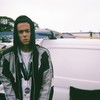Kate Simko is a name chiefly associated with being one of Chicago's finest exported DJs of the last decade. Trading in techno and deep, soulful house, she bears all the mainstay credible DJ credits you would expect, from Berghain to Fabric. Her production work has been similarly well received, most notably her slinky 2012 hit "Go On Then" featuring Jem Cooke. Only, the project we are discussing straight after her performance at March's LEAF event in London's Tobacco Docks is something altogether different.
Advertisement
Simko has spent the last two years studying for a Music for Film qualification at London's Royal College of Music. Her current project, the London Electronic Orchestra, has stemmed from that prolonged period of study. Her decision to take a place on the course was rooted in a desire to master writing orchestral arrangements. "Before now I had been learning theory but not writing it. So I had to learn the ranges and how they blend."
Given that the main skill I acquired at university was being able to remove a bottle top with my teeth, it is impressive that Simko used her time in the academy to develop her own orchestra, surrounded by the perfect collaborators in the shape of her fellow students. During our after-show chat, she is flanked by three members of her collective, Zoe Saubat, Valeria Kurbatova and Sarah Anderson, who are all as excited by the venture as Simko is. Kurbatova, the harpist, explains, "It's very different, especially when you're used to playing Mahler in an orchestra where everything is so strict." From this strict environment, playing an event like LEAF means entering a wholly new musical environment, yet this too has galvanised Kurbatova's enthusiasm, "today I could see the front row, dancing and moving! We want to work harder when we see that response."
The shift registered by her orchestral cohorts also posed challenges for Simko, for her the need to create music that held up under the scrutiny of the classical community. Much of this came down to understanding the necessary disciplines, "Once the music was printed, that was it. There were certain bar numbers and nothing in the way of improvisation with the structure." Yet her electronic background has far from held her back. The solitary nature of the solo producer has been of great use in this new venture. "I think because I've written so much music on my own, I am good at listening. I write music that if I was in the audience I would think, 'that sounds beautiful'." It is this coalescing of structure and instinct that has led to her distinct take on the form, "I know the rules but I'm not afraid to break them."Read our pre-LEAF interview with DJ Harvey here.
Advertisement
Anderson, violinist, firmly believes that Simko's perspective has been hugely beneficial in creating a truly unique working environment "It was the most cohesive genre crossover I've ever worked on," she says, "quite often with classical collaborations, people think it is as simple as saying, 'just come in and make it all classically'. Kate has obviously got the experience to understand that we are all artists with different processes and needs."The admiration within the group for their respective fields is a potent binding agent. As Anderson clarifies, "I think there is something to mention about the delicate balance between the type of people who are good enough to do this, and the people who enjoy it." This particular breed of musician, enamored with both classical and electronic instrumentation is the driving energy behind the project, creating something that values each component with complete respect, and as a result creates something truly harmonious. "I think that is maybe why this group now feels like such a family. That rarely happens."
When we move on to where the group are headed next, there's even more excitement amongst them. Simko tells me, "our EP is done and it'll be a mix of our live sound and then some more tracks that are more classical." I asked further about this, interested that given her electronic following the record was relying more heavily on an orchestral sound. "Well, hopefully it will appeal to an electronic and a classical audience, but I think we are aiming more for the classical angle. Then hopefully the electronic audience I've built up over the last 15 years will trust me and follow!"If the investment of her collaborators are any indication, then she has nothing to worry about. The dedication Simko has inspired in them speaks hugely of her own unshakeable enthusiasm in the project, and the considerable personal effort she has poured into it. The London Electronic Orchestra she has put together have the energy of friendship group first and foremost, and talking to them about their work inspires a present and contagious buzz. As followers of electronic music, Simko's latest venture offers us an excellent opportunity. There are countless instances, where a reputable musician has beefed up or reworked their music with a cursory string section, but it is a rare that an artist envelops themselves within the classical scene to this extent.Given the low temperature of the room we are talking in, we agree it is probably best that we round our conversation up, just in time for me to ask Kate's orchestra if any of them are likely to take up DJing after their experience. I'm roundly laughed at, before Kurbatova suggests, "maybe if I can play some Mahler?" Based on this evening - why not? I reckon it would go off.Follow Angus on Twitter.Photos via Luke Baker.
